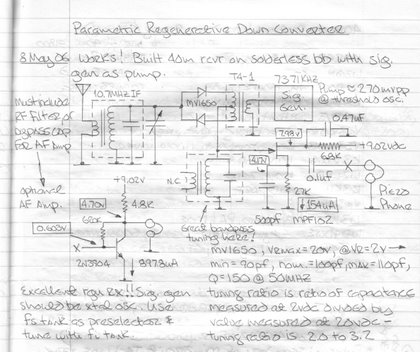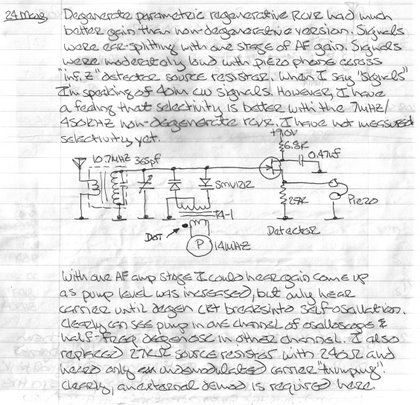Please take a moment to view this You Tube video of "monk-pumped" degenerate parametric amplification. This impressive ceremony - dating back to the 14th century - takes place on special occasions at the Cathedral of Santiago de Compostela in northern Spain [2]. The initial push given to the 53kg (117lb) censer - known as, "O Botafumeiro" - represents the signal to be amplified.
Fundamentally, this is the same technique used by children to "pump themselves up" on a playground swing. I sometimes catch myself absentmindedly employing the same phenomenon while swinging my closed umbrella on my finger as I walk down the street.
My first receiver used a non-degenerate, parametric down-converter to produce regenerative gain at both 7MHz and 371kHz. Two MV1650 varactors and a Minicircuits T4-1 wide-band transformer comprise the pumped reactance. The input signal tank circuit was a 10.7MHz, IF, tuned-transformer, with sufficient parallel capacitance added to resonate at 40m. A 455kHz, IF, tuned-transformer was employed in the idler. Notice, the idler frequency ended up at 371kHz due to the parallel capacitance of the varactor-pair. I used my bench signal generator as the pump. The pump frequency is the sum of both the signal and idler frequencies. "Regeneration" is controlled by adjusting the pump signal level. A JFET "infinite impedance" detector was used to demodulate the signal appearing on the idler tank. Please "click-on" the photos to enlarge them.
Next, is my journal entry for a semi-degenerate parametric down-converter receiver. Raising the pump frequency to two times the working frequency; the input signal and idler signal frequencies merge. We may now dispense with the idler tank and allow the input signal tank to "carry" both the input signal and the "virtual" idler signal. Here I use a pair of surplus SMV1212 varactors that I found on eBay; paying only a few dollars per hundred diodes.
I went on to build a third version, wherein the pump frequency was roughly 700Hz above the signal frequency. This can best be described as a non-degenerate, parametrically amplified, direct conversion receiver with regenerative gain. Obviously, no demodulator is required in this case. But given there is gain at both the signal and idler (at AF, in this case) frequencies; operating too close to the threshold of oscillation with this receiver results in "ringing," due to an excessively narrow AF bandwidth.
Please notice that I've not reverse-biased the varactors in the above "proof of concept" circuits. This is permissible so long as both the input and pump signals remain below the PN barrier-voltage of the varactors; a condition that is rarely, if ever, assured in practice. Thus, a working parametric receiver ought to employ reverse-biased varactors. Another thing I ought to mention is the inherent hysteresis produced at the onset of parametrically induced negative resistance oscillation. This is a classic phenomenon associated with non-linear oscillation.
Parametric amplification invariably involves frequency mixing. Fundamentally, there is parametric up-conversion and there is parametric down-conversion. With up-conversion, the power gain is limited by the ratio of the up-converted frequency divided by the signal frequency. Down-conversion produces attenuation when the pump frequency is lower than the idler frequency. However, a regenerative gain is produced when the pump frequency is above that of the idler signal.
The last mention I noticed of high-frequency parametric amplification in amateur radio literature was an article appearing in the February, 1973 issue of Ham Radio Magazine. Quoting from the text on page 14;
"A parametric up-converter is used in the National R1490/GRR17 wide dynamic range military receiver. The specified linearity of the [mixer] circuit is 137dB and the noise figure is 6dB. All external spurious responses, images, IF breakthrough, cross-modulation, IM, etc. are down more than 100dB."
On 1/12/08 I received a message from an old friend, KC0G. John informs me that G3VA had recently returned to the topic of parametric up-conversion mixers in his November, 2007, RadCom, "Technical Topics" column. To my astonishment, John went on to inform me that Datong Electonics, Ltd. had produced and marketed a parametric up-converting mixer in the 1980's; the PC1! Please click here to find Nick B's page on the PC1; where you may download a specification-sheet as well as the complete service manual - including the schematic diagram! This is fabulous. I had no idea that a high-frequency parametric mixer/amplifier had ever been produced for the amateur radio market. Many thanks, John!
Links
- Le Botafumerio; "Click-on" the little hand; Pull at P.E.=0; Drop at both instances of K.E.=0
- A Mechanical Non-degenerate Parametric Oscillator; IRE, February, 1962 (wonderful model)
- A Frequency-Domain Theory of Parametric Amplification; by Benjamin Leon, MIT, 1959
[1] Landon, V., "The Use of Ferrite-Cored Coils as Converters, Amplifiers and Oscillators," RCA Rev., September, 1949
[2] Sanmartin, J., "Botafumeiro: Parametric Pumping in the Middle Ages," Am. J. of Physics, October, 1984

